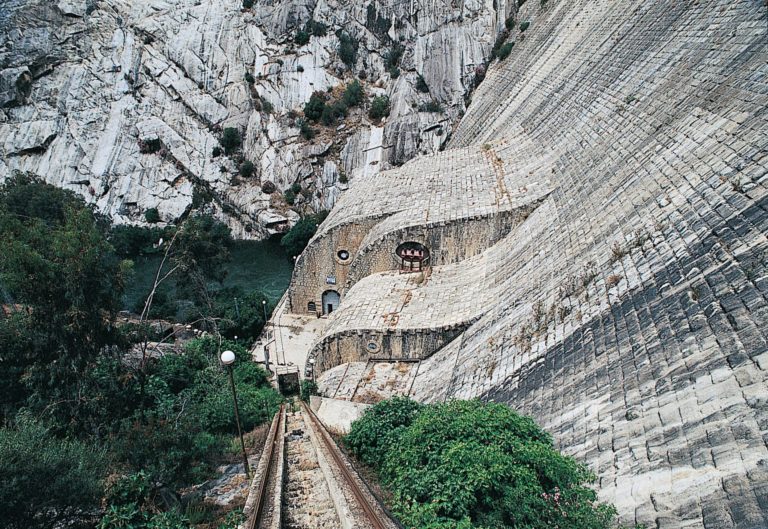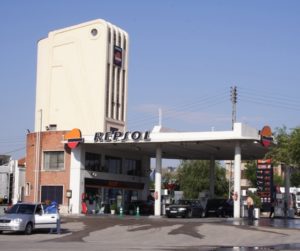
Casto Fernández-Shaw e Iturralde
Madrid, 1896-1978
Casto Fernández-Shaw Iturralde was born in Madrid into a large family. His father was the journalist and poet Carlos Fernández Shaw, who had close ties to the world of music – more specifically, to the zarzuela genre as a librettist, but also as a collaborator of Manuel de Falla. Casto, a student at the Colegio de la Concepción and classmate of Agustín Aguirre and Carlos Arniches, showed remarkable talent in drawing and mathematics. Under the tutelage of his maternal uncle, Daniel Iturralde McPherson, following the untimely death of his father in 1911, he chose to pursue the profession of mining engineer, since he was already an aspiring inventor. He soon discovered his true calling, however – architecture – and he began his studies at the Madrid School in 1913. He earned his degree in 1919. His favourite teachers were Aníbal Álvarez, José María Anasagasti, Modesto López Otero and, above all, Antonio Palacios, with whom he spent the early years of his professional career.
In 1917, when his uncle died before he finished his studies, he joined Palacios’ office and collaborated on the Círculo de Bellas Artes project, where he was in charge of drafting the floorplans. After finishing his degree, he worked in the Otamendi brothers’ studio, taking part in projects for the Metropolitan Urban Development Company, both in the hotel sector and in the buildings on avenida Reina Victoria. With Julián Otamendi, he designed the famous Titanic buildings (1919-1923), which introduced a new typology based on hygienist principles, and which evidenced his admiration for American skyscrapers, a fascination that continued throughout his life. That admiration was also part of what motivated his long trip to the United States in 1949, in a semi-escape from the suffocating national architectural panorama of the time. It was also reflected, on the small scale of Madrid’s Gran Vía, in the Secession style façade of the Coliseum Building (1930-1933, with Pedro Muguruza for maestro Jacinto Guerrero), in the façade of the Banco Hispano de la Edificación (1943-1944, originally by Ortiz de Villajos from 1930) and, more ambitiously, in his competition designs for The Chicago Tribune (1922) and for a hypothetical Exhibition Palace, which he called the “Vertical Museum” (1950-1951).
Carlos Mendoza, an engineer and co-director of the Metropolitan Urban Development Company, was surprised by his design for a Monument to Civilization, which won a prize at the National Exhibition of Fine Arts in 1920 and which Fernández-Shaw had intended for a dam. Mendoza hired him to collaborate on the architectural plans for the power stations in El Carpio (1920-1925), Alcalá del Río (1925-1931), Encinarejo and Jándula (1927-1930). In the case of Jándula, the monumentalism and slight constructivist historicism of the first two were replaced by an expressionist design with great formal beauty that combined modern architecture and engineering into a functional and fluid whole, and which, still today, is the subject of an ongoing extensive bibliography.
In 1927, Fernández-Shaw built a project considered one of three that marked the beginning of the Modern Movement in Spain: the Porto Pi petrol station on calle de Alberto Aguilera in Madrid, a rational-constructivist-machinist manifesto that presaged his aerodynamic design for the Barajas airport (1929) and a large number of projects, mainly residential buildings, particularly the paradigm of the homes he designed on calle Menéndez Pelayo in Madrid (1933-1935). Other examples include the Clínica Luque or “Sanatorium for the modern woman”, the film studios in Aranjuez, and the side façades of the Coliseum, a building with multiple programmatic and stylistic signifiers. This creative phase, which included the petrol station on the avenida de Aragón (1958-1960), demonstrated a functional asceticism that continued through much of his professional career, even in a second post-war reading, in collective and single-family homes, markets (San Fernando, Barbate, Tetuán), offices, etc., and through to the building on calle Pelayo in Madrid for the Spanish Society of Authors and Publishers (SGAE) (1968-1970).
Yet Fernández-Shaw’s personality was multifaceted and hard to classify; he was a rara avis, an inventor of architectures that crossed boundaries, who was considered by figures such as Juan Daniel Fullaondo to be the only Spanish futurist architect, while he was also situated within rationalism, expressionism, constructivism, and other avant-garde movements. His interest in engineering was reflected in his impressive 1929 design for the Faro de Colón, which eventually became the Torre del Espectáculo; in his various designs for radial car parks and garages, which earned him a gold medal with his Sproga project at the 1961 Inventors’ Fair in Brussels; and in his passion for transport architecture, evident in the railway, bus and gyroplane station for Plaza de Colón (1932-1933, updated in 1936). There are excellent examples of all this and of his cutting-edge, utopian, science fiction architecture in the extraordinary models that were donated to the government, now held at the Centro de Arte Reina Sofía, as well as his three celebrated competition projects from the 1960s: the Opera House and the Convention Centre in Madrid, and the Spanish Pavilion for the New York World’s Fair.
Along the way he was an accomplished chess player and comic illustrator; he took in the influence of Konstantín Melnikov at the 1925 International Exhibition of Modern Decorative and Industrial Arts in Paris, where he won the Gold Medal for the Salto del Carpio. He was an athenaeum member, a board member for the architecture section of the Círculo de Bellas Artes, treasurer of the Central Society of Architects, an active member and administrator of Manuel de Falla’s Atlántida; he was involved with the Red Cross, El Canoe [Real Canoe Sports Club] and the Association of Friends of Spanish Castles. There were his stays in Marseille, Paris and London, his post-war interventions in Morocco and Gibraltar, and his trips to the United States and Venezuela. He was a lecturer and promoter of architecture and art exhibitions. There were his eclectic architectures that paid for scale models, competitions, and a wide variety of heterodox initiatives; and his passion for disseminating projects and ideas through the unique magazine Cortijos y Rascacielos, which spanned seven years before the war and 11 years after it, and into which he poured the dreams that could only seldom become realities.
Biography by Cristina García
Bibliography
- CABRERO GARRIDO, Félix, GARCÍA PÉREZ, María Cristina, “Casto Fernández-Shaw e Yturralde”, en AA VV, Diccionario biográfico español de la Real Academia de la Historia, RAH, Madrid, vol. XIX, 2011 (REAL ACADEMIA DE LA HISTORIA, Diccionario biográfico electrónico, 2021.
- CEPEDANO BETETA, Elisa, “Casto Fernández-Shaw: imagen, arquitectura. Marbella, un discurso de la modernidad”, en Congreso Internacional de Historia de la Arquitectura Moderna Española 8, Las revistas de arquitectura (1900-1975): crónicas, manifiestos, propaganda… actas preliminares, Pamplona, 3-4 May 2012, T6 Ediciones, Pamplona, 2012, pp. 403-410.
- FLORES SOTO, José Antonio, “El valor de la arquitectura popular en la búsqueda de una modernización de la arquitectura española de posguerra a través de la revista Cortijos y Rascacielos”, in Congreso Internacional de Historia de la Arquitectura Moderna Española 8, Las revistas de arquitectura (1900-1975): crónicas, manifiestos, propaganda… actas preliminares, Pamplona, 3-4 May 2012, T6 Ediciones, Pamplona, 2012, pp. 483-492.
- MUÑOZ BASTIDE, Santiago, “El Museo imaginario de Casto Fernández-Shaw”, in Lars: cultura y ciudad 18, 2010, pp. 24-29 [ejemplar dedicado a Visiones de la modernidad].
- FERNÁNDEZ-SHAW, Casto, “El día y la noche de la vida, pensamiento y obra de un arquitecto singular: autobiografía”, in GARCÍA PÉREZ, María Cristina, CABRERO GARRIDO, Félix, eds., Casto Fernández-Shaw, arquitecto sin fronteras, 1896-1978 [catálogo de la exposición a cargo de —], Electa, Madrid, 1999, pp. 266-300 [título y montaje facticios de María Cristina García Pérez y Félix Cabrero Garrido a partir de textos del arquitecto].
- GARCÍA PÉREZ, María Cristina, CABRERO GARRIDO, Félix, eds., Casto Fernández-Shaw, arquitecto sin fronteras, 1896-1978 [catálogo de la exposición homónima], Ministerio de Fomento, Dirección General de la Vivienda, la Arquitectura y el Urbanismo, Madrid; Junta de Andalucía, Consejería de Obras Públicas y Transportes, Sevilla, Electa, Madrid, 1999.
- GARCÍA PÉREZ, María Cristina y CABRERO GARRIDO, Félix, “Casto Fernández-Shaw y la interminable aventura expresionista de un navegante del futuro”, in Arquitectura 318, 1999, cover and pp. 36-47.
- CABRERO GARRIDO, Félix, GARCÍA PÉREZ, María Cristina, Casto Fernández-Shaw, inventor de arquitecturas [folleto de la exposición homónima celebrada en el Ministerio de Fomento, 21 May to 19 July 1998], Ministerio de Fomento, Centro de Publicaciones, Madrid, 1998.
- URRUTIA NÚÑEZ, Ángel, “Personalidad y obra de Casto Fernández-Shaw Iturralde (1896-1978)”, in AA VV, Arquitectura española, siglo XX, Cátedra, Madrid, 1997, pp. 311-317 y 13, 22, 153, 155-156, 161, 165, 204, 242-245, 260, 349, 354, 370, 383-385, 387 y 514.
- BARREIRO PEREIRA, Paloma, Casas baratas. La vivienda social en Madrid, 1900-1939, Colegio Oficial de Arquitectos de Madrid, Comisión de Cultura, Madrid, 1992, pp. 149-153, 221-223, 228, 372 y 384.
- FERNÁNDEZ ALBA, Antonio, “Círculo en fuga, [en la muerte de Casto Fernández-Shaw]”, in Velada memoria: De las intenciones del enigma en el arte y la arquitectura, Colegio Oficial de Arquitectos de Madrid, Servicio de Publicaciones, Madrid, 1990, pp. 143-146.
- GARCÍA PÉREZ, María Cristina, Casto Fernández-Shaw, documentos para una utopía [folleto de la exposición homónima celebrada en la Sala de Exposiciones del Ayuntamiento de Las Rozas, 10-28/02/1987], Ayuntamiento de Las Rozas, Madrid,1987.
- FERNÁNDEZ-SHAW, Casto, “Proyecta, que algo queda” [selección de textos e imágenes de Francisco Chauton; nota previa de Juan Daniel Fullaondo; tabla cronológica], in Poesía 11, 1981, pp. 8-15 y 17-66 [monography].
- CABRERO GARRIDO, Félix, Casto Fernández-Shaw, Servicio de Publicaciones del Colegio Oficial de Arquitectos de Madrid, Madrid, 1980.
- LARRODERA, Emilio, “Murió el arquitecto Casto Fernández-Shaw”, in Boletín COAM, 290, 10 May 1978.
- CABRERO GARRIDO, Félix, “Casto Fernández Shaw”, in Arquitectura 189, 1974, pp.1-94 [número monográfico].
- “HOMENAJE a Casto Fernández-Shaw” [con “Datos biográficos…” y “Consejo a los jóvenes arquitectos”], in Arquitectura 157, 1972, pp. 41-43.
- FULLAONDO, Juan Daniel, “Casto Fernández-Shaw”, in Nueva Forma 70, 1971, pp. 26-32 [número monográfico dedicado al expresionismo].
- FULLAONDO, Juan Daniel, “Casto Fernández-Shaw”, in Nueva Forma 38, 1969, pp. 35-50 [número monográfico dedicado al futurismo y al constructivismo].
- FULLAONDO, Juan Daniel, “Las mil y una noches de Casto Fernández-Shaw”, in Nueva Forma 45, 1969, pp. 2-82 [número monográfico dedicado a Casto Fernández-Shaw].
- GALLO, Federico, dir., “Casto Fernández-Shaw”, in Esta es su vida, Televisión Española, May 1968.
- FLORES PAZOS: “1927, primera arquitectura moderna en España: Mesa redonda con Rafael Bergamín, Fernando García Mercadal y Casto Fernández-Shaw”, in Hogar y Arquitectura 70, 1967, pp. 37-48.
- CARVAJAL FERRER, Javier, “Carta abierta a Casto Fernández-Shaw”, in Arquitectura 72, 1964, pp. 21-25 y cubierta.
- FERNÁNDEZ-SHAW, Casto, “Proyectos presentados a la Exposición Bienal Hispano Americana de Arte en Madrid, 1951”, in Cortijos y Rascacielos, Madrid, 1951.
- FERNÁNDEZ-SHAW, Casto, “Ayer, hoy y pasadomañana de la arquitectura” [extracto de la conferencia pronunciada en el Consejo Superior de Investigaciones Científicas para el Instituto de la Construcción y el Cemento, 29/12/1949], in Cortijos y Rascacielos 56, 1950, p. 37.
- FERNÁNDEZ-SHAW, Casto, Arquitectura aérea y antiaérea = Aircraft and anti-aircraft architecture [conferencia pronunciada en el Instituto Técnico de la Construcción y Edificación, 17.04.1942], Cortijos y Rascacielos, Madrid, 1946 [Reproduced in Cortijos y rascacielos 37, anexo, 1946-1947, pp. 1-31].
- FERNÁNDEZ-SHAW, Casto, Arquitectura y electricidad: ¡luz, más luz! [conferencia pronunciada en el Círculo de la Unión Mercantil e Industrial de Madrid, 11 de abril de1945], Edición del autor, Madrid, 1946.
- FERNÁNDEZ-SHAW, Casto, “La obra del arquitecto don Antonio Palacios”, in Cortijos y Rascacielos 33, 1946, pp. 30-37.
- FERNÁNDEZ-SHAW, Casto, “Palacios ha muerto”, in Revista Nacional de Arquitectura 47-48, 1945, pp. 390-393 [article reproduced in Diario Madrid].
- “Arquitectura, 1928: nuevo arte en el mundo”, in La Gaceta Literaria 32, 15 de abril de 1928, pp. 1-6 [by Fernando García Mercadal, reproduced in Hogar y Arquitectura 70, 1967, pp. 49-56].










